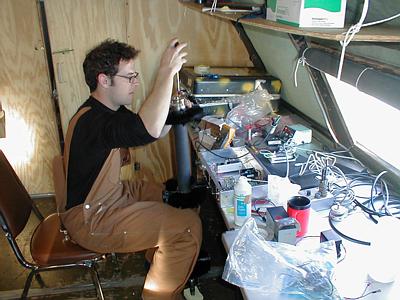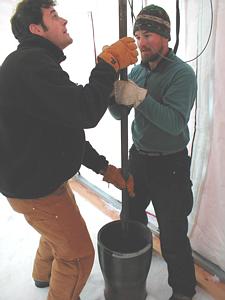10 December, 2000
Dust and Neutrinos
Ryan Bay from the University of California at Berkeley is the newest member of our team. He arrived this week to test out a new instrument. The device will be lowered down the main borehole at Siple Dome. Its purpose is to detect dust in the ice layers as it descends to the bottom of the ice sheet.
The instrument that Ryan designed is about a meter in length. It emits ultraviolet light from the top of the dust logger into the ice. At the bottom of the device is a light detector that will measure the amount of light that passes through the ice. Ultraviolet light is transmitted through ice quite well but if dust parcticles are present, some light will be absorbed.
Why would you want to know if there is dust in the ice? The presence of dust can yield information about past climates. It often appears in ice that formed during an ice age when the climate was colder and drier. Volcanic eruptions produce ash that can also show up in ice layers.
Ryan developed this instrument for another purpose. He has been involved with the AMANDA Project at the South Pole. AMANDA uses strings of light detectors frozen deep in the ice sheet to detect neutrinos. Neutrinos are elusive subatomic parcticles produced by cosmic processes in space. High energy neutrinos that pass through the Earth occasionally interact with protons creating another variety of parcticle called a muon. Light from these passing muons is what registers on the light detectors. AMANDA detects about one of these events per day.
The strings of light detectors are placed in the ice at a depth of 1400 to 1900 meters (4600 to 6200ft). At these depths the ice is free of bubbles that might otherwise interfere with the passage of light. Ryan's dust logger is designed to identify layers of ice containing dust, which would also affect light transmission.
The test was a success. The instrument produced consistent data in three logs of the main borehole. Occasional drops in light transmission were detected. Checking the ice cores recovered from the hole a few years ago may show whether the decreases are due to dust.

Ryan Bay is in the beaker hut connecting the batteries in the dust logging instrument.

At the top of the instrument are three light-emitting diodes (LED) that give off ultraviolet light into the ice. At the bottom end is a photo multiplier tube (PMT) that detects the light that had passed through the ice. Three sets of black brushes prevent light from leaking down the borehole. Two sets of metal springs keep the device centered in the hole.

Ryan and Bob are carefully lowering the dust logger and the attached weight into the borehole.
Contact the TEA in the field at
.
If you cannot connect through your browser, copy the
TEA's e-mail address in the "To:" line of
your favorite e-mail package.
|
